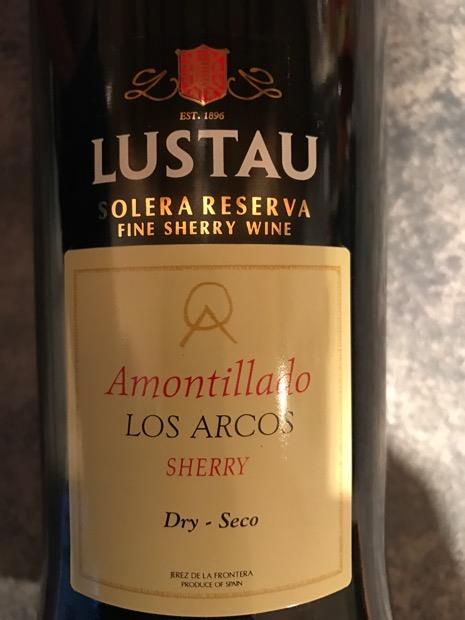
External search
Google (images)
Wine Advocate
Wine Spectator
Burghound
Wine-Searcher
Vintages
2021
2013
2012
2011
2007
N.V.
From this producer
Show all wines
All tasting notes
|
| Drinking Windows and Values |
| Drinking window: Drink between 2015 and 2016 (based on 2 user opinions) |
| Community Tasting History |
| Community Tasting Notes (average 88 pts. and median of 88 pts. in 1 note) - hiding notes with no text | | | Tasted by S. Connery on 4/18/2020 & rated 88 points: Sødmefull, lang tørr utgang. Til spekeskinke. Har ikke drukket opp alt ennå. (360 views) |
| Emilio Lustau Producer websiteSpain Vinos de España - Wines of Spain (Instituto Español de Comercio Exterior) | Wikipedia
Wine Map on weinlagen-info
Spain is the third largest wine producing nation in the world, occupying the majority of the Iberian Peninsula with vast diversity in climate, culture, and of course, wine. From inky, dark reds of the [Priorat] to dry, white Finos from Andalusia, Spain can easily boast of elaborating a wide variety of notable styles. Within Spain there are currently 62 demarcated wine regions, of which a handful have gained international recognition: [Rioja], Priorat and [Ribera del Duero]. Yet these regions are only a small sample of the high quality wines Spain produces. Regions such as Cava, Penedes, Somontano, Galicia, Rueda and Jerez are only a few of the numerous regions worthy of exploration throughout Spain. Spain can also lay claim to having the most land under vine in the world, growing up to, by some accounts, 600 indigenous varietals of which Tempranillo is their most well known. Other popular varietals include [Garnacha], Bobal and Monastrell for reds and for whites; the infamous [sic] Palomino Fino grape which is used in the production of sherry wine, Pedro Ximenez in Montilla Morilles, Albarino used in the creation of the bright, effervescent wines of Galicia, and Verdejo in Rueda. - Source: - Catavino.net
Spain is not in the forefront of winemaking for its dessert wines, other than for its sweet wines from Sherry country including the highly revered Olorosos (when sweetened). But apart from Sherry Spain has a range of styles of dessert wines, ranging from the those made from the Pedro Ximenez grape primarily in Jerez and Montilla-Moriles) to luscious, red dessert wines made in the Mediterranean from the Garnacha (Grenache) grape. Some good Moscatels are made in Mallorca, Alicante and Navarre. The northwest corner of Spain, Galicia, with its bitter Atlantic climate, is even making dessert wines, called “Tostadillos” in the village of Ribadivia (similar to France’s “Vin de Paille”). The Canary Islands have made interesting dessert wines for centuries (they are mentioned by Shakespeare, for example) and in recent years the quality of winemaking has been improved and the Canary Islands wines are being better marketed now. The winemaking styles for “Vinos Dulces” are also diverse, from “Late Harvest” (Vendimia Tardía) to “Fortified Wines” (Fermentación Parcial). Based on in-spain.info.Andalucía Andalucía and its wines
DOs
Wikipedia
Map on weinlagen-info
Two suggestions for listing Sherries and Manzanilla wines from a frequent user in a time of change:
The vast majority of these wines are solera-produced and are therefore nonvintage; they should not be listed under a vintage date. A Saca (or bottling) can be listed with a date under Designation, since each bottling is liable to be somewhat different. Dates of accession to your cellar, if it seems important, can also be listed in Designation. <b> Only an Anada (Vintage) wine should bear a vintage date.</b>
Currently, Manzanilla wines (what used to be called Manzanilla Fino) need only be listed as coming from the wine region Manzanilla-Sanlucar de Barrameda. This assumes the 'Jerez' region, which need not be mentioned. For older wines, there may be some confusion about the origin and type. I would suggest following the label as much as possible. jhtJerez-Xérès-Sherry Wiki page on Sherry
Wiki page in Spanish on Jerez
Official website of the Consejo Regulador of Jerez-Xérès-Sherry, Manzanilla de Sanlúcar de Barrameda and Sherry Vinegar
Oloroso, sherries are ”born” when fino fails to form on sherry at the beginning of its life in the bodega or when a producer decides to fortify the wine enough such that the growth of flor is inhibited. |
|




